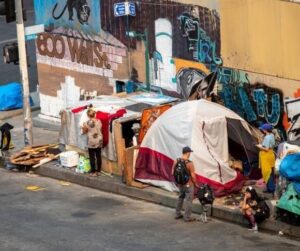Homelessness is soaring in Los Angeles and its surrounding suburbs just as the uber-progressive California city is poised to officially declare itself a “sanctuary city” for illegal aliens. But don’t expect establishment entities wringing their hands over the problem to put two and two together. A narrative of blazing tragedy must be rolled out, and it won’t include uncomfortable acknowledgment of the gasoline being poured on the inferno.
“The 2023 Greater Los Angeles Homeless Count results were released [June 29], showing a 9% rise in homelessness on any given night in Los Angeles County to an estimated 75,518 people and a 10% rise in the City of Los Angeles to an estimated 46,260 people,” an annual report conducted by the Los Angeles Homeless Services Authority states.
Leaving Something Out
Democrat Mayor Karen Bass attended the press conference at which the report was announced. “L.A.’s homelessness response leaders… all agree that more must be done to address the root causes,” LAHSA declares. Yet there is not one mention in the report of the “undocumented” elephant in the room.
The same absence can be seen in big-box newspaper giant The Los Angeles Times’ lengthy article on the report. “Efforts to house people, which include hundreds of millions of dollars spent on shelter, permanent housing and outreach, have failed to stem the growth of street encampments,” the paper observed. “Since the 2015 count, homelessness has increased by 70% in the county and 80% in the city.”
This stunning rise has left local officials perplexed. “In struggling to explain the continued growth of homelessness, [LAHSA’s new chief executive Va Lecia] Adams Kellum acknowledged that the reasons are not fully known, but she pointed to economics as the underlying cause,” the paper wrote.
The bewilderment is contagious.

(Allen J. Schaben / Los Angeles Times via Getty Images)
Swamp-connected management consulting company McKinsey & Company has issued several reports on homelessness in LA in recent years. As Liberty Nation reported in March, Biden administration Transportation Secretary Pete Buttigieg and Chelsea Clinton both began their professional careers at McKinsey.
In an exhaustive article outlining its March report, McKinsey declares homelessness in Los Angeles to be a “unique crisis demanding new solutions.” Needless to say, securing the border and enforcing US immigration law are not suggested fixes.
“LA County’s population, its growth rate, and the vast space and jurisdictions it covers create unique challenges requiring comprehensive, far-reaching solutions,” the powerhouse firm writes. “The total number of [people experiencing homelessness] is growing quickly: it increased by roughly 56 percent from 2015 to 2022.”
An estimate is included of what the numbers are expected to look like in coming years. Based on current growth rates, the company says 113,000 homeless people may reside in LA County by 2028.
Oblivious to the time-tested economic truism that when you subsidize something you get more of it, McKinsey scratches its faceless corporate head over how this astonishing increase has come as more and more money has been thrown at the crisis.
“Major funding increases to the Los Angeles Homeless Services Authority, the lead agency in the county’s continuum of care, have risen in parallel with rising homelessness in LA,” the company report reads. “In the 2014–15 financial year, LAHSA received funding of $63 million. By 2022, funding had increased nearly 13-fold to about $808 million. In the same period, the number of PEH in LA County increased by 56 percent.”
Los Angeles Reality Dodgers
There is another swelling demographic residing in Los Angeles, and despite what city officials, the leading news outlet in town, and a renowned consulting company won’t admit, it contributes heavily to the homelessness crisis.
The LA City Council in June “approved a motion calling on various city departments to take the necessary steps for Los Angeles to officially become a sanctuary city” for illegal aliens, KCAL-TV reports. Former Mayor Eric Garcetti had already granted vast protections to illegals in a 2019 executive order, but the new effort is meant to codify it in city law.
“What this (motion) means is a clear message to the [illegal alien] community… that the city should be looked as an entity that you can trust, that you can come to and that you can look to for help,” council member Hugo Soto-Martinez said.
One has to dig beyond the 24-news cycle to find it, but here’s a surprise reveal for LAHSA and friends: more illegal aliens means more homelessness. Cynthia Sanchez is “director of Proyecto Pastoral, the nonprofit that runs the shelter at Dolores Mission church,” a 2016 article at NPR affiliate LAist Radio relates. “Sanchez and others who work with the homeless immigrants see them as a shadow population within Los Angeles’ growing homeless ranks,” the article continues. “Most of those who wind up on the street are single men, Sanchez said. They are here on their own without families in the US who often send money back home to relatives.”
Single males illegally coming to America and living in the streets of the nation’s second-largest city. Why isn’t this group emphasized in LAHSA’s account of homelessness in LA along with the fentanyl addicts and the mentally ill? Reports on the number of illegal aliens in Los Angeles County vary from roughly one million to as much as two million. As with the figure for the US at large, the higher number is likely closer to the truth.

(Photo by Getty Images/Bob Riha, Jr.)
“On Nov. 17, the Los Angeles Homeless Services Authority, or LAHSA, hosted a panel via Zoom about the rise of Latino homelessness in LA County,” local news site Random Lengths News reported last year.
“Marina Genchev, LAHSA associate director in systems of planning, said that Latinos are the largest demographic group in the county, making up about 49% of the population. There are about the same number of homeless Latinos proportionally, as they represent 44% of the homeless population,” the article read.
“Genchev said that the Latino homeless population also increased between 2019 and 2020, by 12%. ‘Things are increasing and getting worse,’ Genchev said.”
An overtly pro-illegal alien 2017 report by UCLA’s Latino Policy & Politics Initiative offers more clues to the homeless surge mystery:
“Undocumented individuals tend to be employed in low-paying jobs with high turnover and few benefits…. They have lower levels of education when compared to U.S.-born residents. Undocumented individuals are more likely than permanent residents and citizens to be forced to move because they cannot afford to pay rent, experience periods of decreased income, have difficulty with transportation for work, and experience periods of homelessness.”
A bulging “root” of the homelessness problem is staring LA officials right in the eye. But it would be politically inexpedient to address it. As it grows undisturbed, so will homelessness in the City of Angels. And all the money afforded to hollow solutions will be nothing more than mulch.
All opinions expressed are those of the author and do not necessarily represent those of Liberty Nation.
Do you have an opinion about this article? We’d love to hear it! If you send your comments to [email protected], we might even publish your edited remarks in our new feature, LN Readers Speak Out. Remember to include the title of the article along with your name, city, and state.
Please respect our republishing guidelines. Republication permission does not equal site endorsement. Click here

